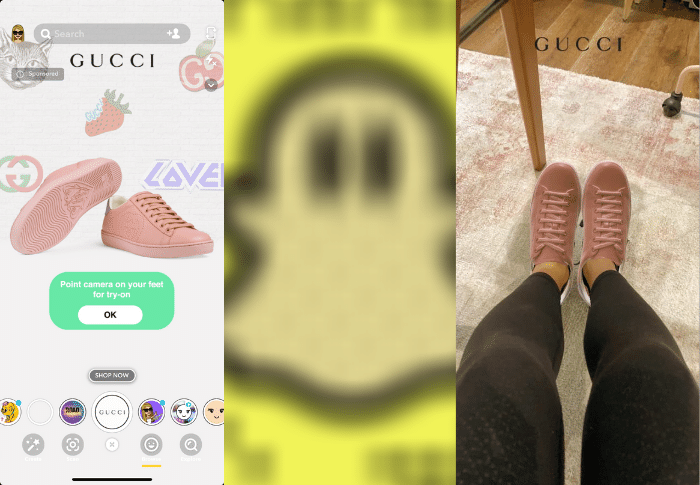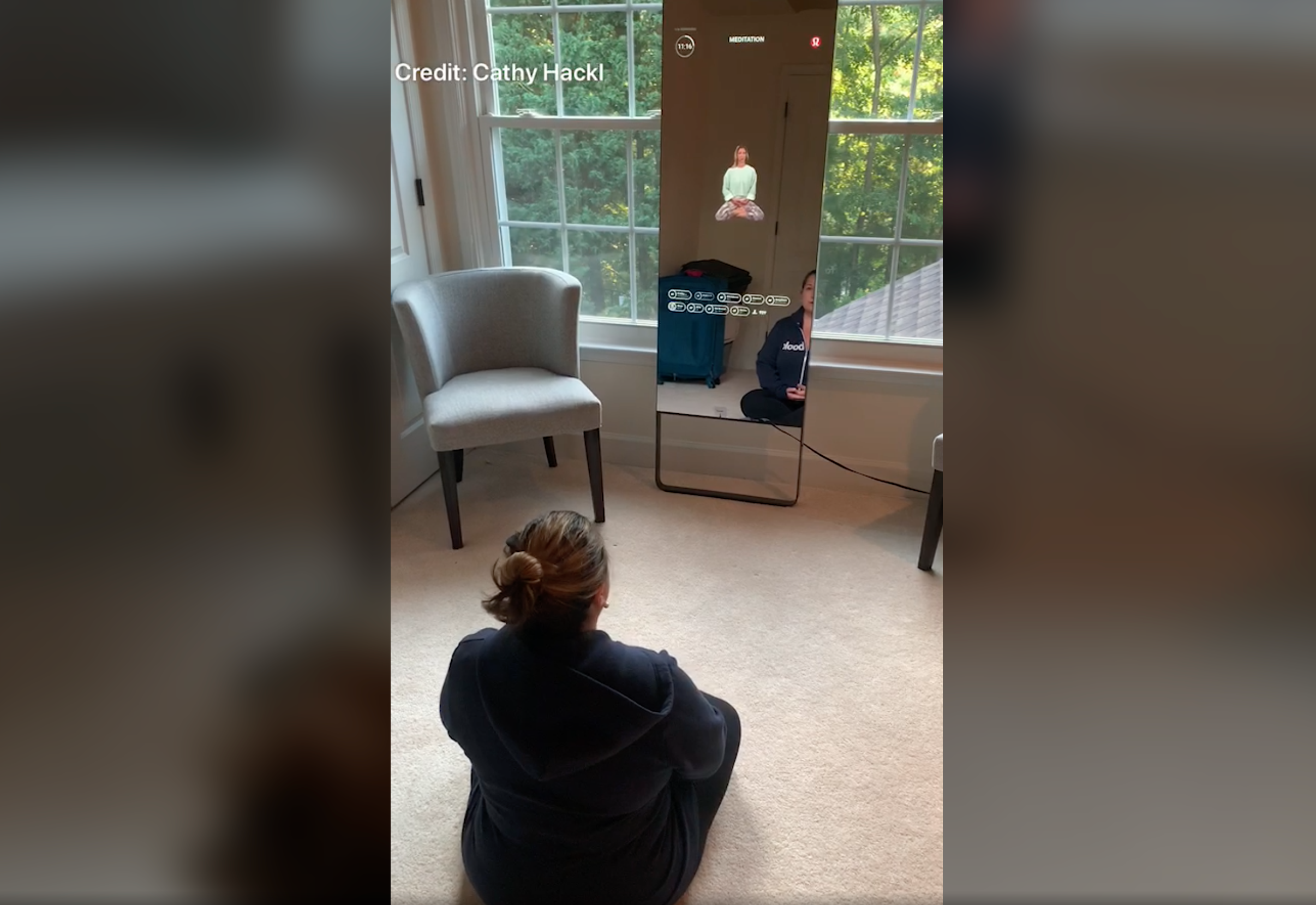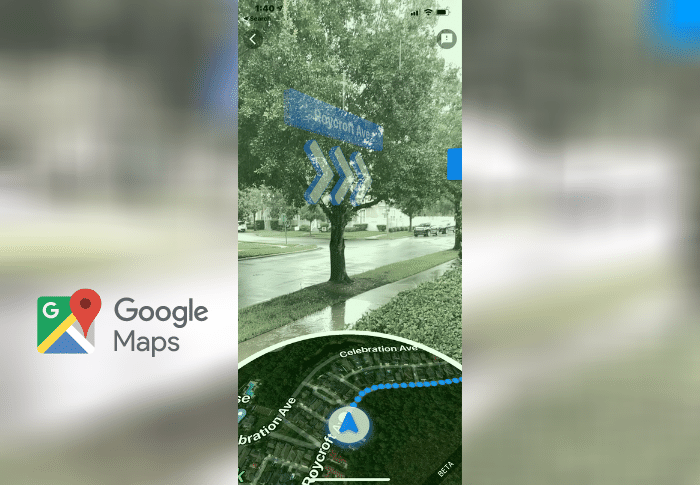Augmented reality is more than a buzzword.
Move over human influencers; virtual beings might be the next-gen in the near future of marketing.
Ever want to grab a headset and meet your client in virtual reality instead of Zoom – see what your home office makeover could look like using augmented reality or create a virtual copy of yourself and send it off to teach your next webinar or Facebook Live?
Digital marketers are facing new realities, thanks to pandemic disruptions, diversity movements, and social distancing.
Everything – from virtual spaces, micro-messaging to digital creators to platform targeting – has completely turned marketing upside down in the last few months.
Defining Digital Marketing Realities
Virtual reality (VR), augmented reality (AR), mixed reality (MR), machine learning, and now virtual beings are all terms digital marketers need to become familiar with sooner than later.
They have quickly become one of the most accessible ways to market, communicate, engage, and teach.
Here are some of the latest definitions to add to your marketing speak.
Virtual Reality
Virtual reality is when you are in a fully immersive environment (computer-simulated and video).
Think gaming with a headset only this is no game. Imagine your avatar is meeting with your co-worker’s avatar in your company board room on a platform such as Alt Space VR.
VR gives the user the feeling of being in that environment, instead of the one they are at physically.
Augmented Reality
Augmented reality is the overlaying of visual content within your existing environment using a device such as glasses, or your smartphone through apps – think Snapchat or Instagram Filters.
Mixed Reality
Mixed reality, also known as spatial computing, is a hybrid version of reality merging a virtual environment and a real environment.
Think Princess Leia in “Star Wars” or fast-forward today to send a holographic press release with your CEO as a hologram.
Machine Learning
Machine learning refers to the simulation of human intelligence in machines programmed to think like humans and mimic their actions.
Think R2D2 is now flipping hamburgers for White Castle, or you have a two-way human-like conversation to solve a health problem via messaging.
Virtual Being
Virtual Being is a character that you know isn’t real but with whom you can have a two-way emotional relationship.
Think Twitter’s founder Biz Stone as your next keynote or Deepak Chopra conducting a meditation for you.
The catch – it’s not them, it’s via their Virtual Being.
Brands and marketers can now create a virtual being as part of its influencer’s marketing strategy, a computer-generated being programmed to be entirely relatable to your buyer persona.
five AIs talking with each other powered by @aifdn
digital @DeepakChopra is now doing a guided meditation to calm the AIs down (Zoom connectivity issues 😅)
“now my AI can transcend my limitations to share my knowledge with any person now, or in the future” – Digital Deepak pic.twitter.com/29i9vv36u5
— Alice Lloyd George (@alice__LG) July 15, 2020
Why Focus on New Marketing Realities?
Ecommerce Is Revolutionized
When heading out to the mall for retail therapy is not an option, AR and social networks like Snapchat are coming to the rescue.
While trapped in a global health crisis, augmented reality gives marketers and brands the power to thrive without putting consumers at risk.
Case in point – Gucci recently launched its first-ever shoe-try-on lens with Snapchat using the powers and style of augmented reality.
All you have to do is scan the promo shop code and get access to try-on the latest trends in footwear fashion.

Engagement Is a Close Encounter of a New Kind
AR and VR make engaging with your audience accessible in this era of social distancing, quarantine, and beyond.
Virtual concerts, fashion shows, and augmented tours are allowing brands to entertain, educate, and launch without a physical audience.
Social networks are the platform and in many cases, no headset is required.
John Legend with Wave, a social music venue, hosted his first virtual live concert.
The virtual concert attracted more than 500,000 attendees and raised awareness for Legend’s FREEAMERICA campaign, with the goal of transforming the U.S. criminal justice system.
Attendees watched John Legend’s avatar perform his legendary songs which marked history in virtual reality events this month.
During the live event, the real John Legend took to his social channels to interact with his fans.
The Fabric of Reality: launching on July 29, a pioneering #VirtualReality fashion show in partnership with Kaleidoscope, The Museum of Other Realities and the Fashion Innovation Agency#RYOT presents the next era of #virtual #fashion shows https://t.co/lXU1vi6glc #VR pic.twitter.com/MOB9Cg1K1E
— Rob Crasco😷XR VR AI Social Media Tech Influencer (@RoblemVR) July 16, 2020
Storytelling Becomes Immersive & 3D
While all this new marketing technology might sound daunting and think again.
Facebook is making it easy to jump in and experiment with immersive content.
Want to stand out in the feed?
Try using the 3D photo images or panorama images turning into 360 images on mobile.
National Geographic takes one small step for mankind and one large step for AR by taking climbing the world’s highest mountain using immersive storytelling and AR.
Relationship Building
Connecting with your audience is about getting up close and personal.
Why would Lululemon buy Mirror, the interactive fitness company?
Experts say the future of fitness (or any industry) is all about creating meaningful content, connecting with customers, gaining loyalty, and the keyword, immersive relationships.
“During COVID, I’ve been meditating and working out w/my MIRROR. It’s like having an #AR personal trainer at home,” said Cathy Hackl, Futurist AR/VR Tech expert and author of the upcoming book “The Augmented Workforce”.
“I like how this #tech has allowed me to experience a part of the #future of fitness and AR and how its adoption has been accelerated by the pandemic,” Hackl added. “And if Lululemon turns this into a sales channel that can offer personalized gear and workout recommendations, it’ll be well worth the investment.”

5 Ways to Use New Marketing Realities of AR, VR & More
1. Humanize Your Brand & Bring It to Life
“In many ways, virtual reality is live video’s next phase,” said Navah Berg, Social VR expert and host of The Hive VR.
VR gives a sense of real, raw, and being there type of feeling more than a two-way Zoom video could ever do.
As virtual reality becomes a marketing reality, virtual people become part of the cast.
The World Health Organization (WHO) recently launched a campaign using its first virtual health worker named Florence. Her mission is to help users quit tobacco use.
“Users can rely on Florence as a trusted source of information to achieve their quit goals. She can also help recommend tobacco users to further national toll-free quit lines or apps that can help you with your quit journey,” said WHO on it’s official YouTube website.
To help over 1 billion tobacco users quit, WHO is launching Florence, a digital health worker that combats misinformation about #COVID19 and tobacco and gives recommendations and tips for quitting 👇 pic.twitter.com/QrjKNgYNus
— World Health Organization (WHO) (@WHO) May 31, 2020
2. Prepare for Crisis Communications
Who would have predicted the crisis the COVID pandemic has spread across all industries.
What does diversity feel like?
Using VR, a company called Live in Their World allows users to experience workplace scenarios in which bias, inequity, and incivility arise.
Using #VR, a company called Live in Their World allows users to experience #workplace scenarios in which bias, inequity, and incivility arise.
A #VirtualReality #Bias #Simulator https://t.co/TGFcIfBw4r #BLM #BlackLivesMatter pic.twitter.com/zPxsSGi1fI
— Rob Crasco😷XR VR AI Social Media Tech Influencer (@RoblemVR) July 15, 2020
Crisis or no crisis, VR might be the answer to new ways of teaching.
PwC recently released a 10-month study analyzing the value of Virtual Reality for soft skills training.
Part of the finding reported VR learners are faster to train, more confident, more emotionally connected, and more focused versus classroom/e-learners.
3. Amplify Your Company’s Media Relations
If you are in the digital marketing and public relations world, AR/VR and machine learning are bound to come into play.
Storytelling and reporting news and experiences to the media are destined to make VR and AR the new journalistic normal to stand out with your brand’s news.
An example application can be:
- As simple as using machine learning to complete redundant tasks in communication and media relations (such as list building and research).
- Using machine learning on your website newsroom to start a meaningful, deeper, and segmented relationship with your website visitors.
We used to send press kits, now we can we send journalists and bloggers branded, exclusive immersive content.
If influencer marketing is part of your strategy, imagine creating a digital person to be your next influencer spokesperson or a host of your web series.
Move overwritten and visual communication, augmentation is here to enhance and bring to life the message.
Hackl unveiled the world’s first holographic press release in 2018 at a PRSA conference using AR technology with Facebook and Snapchat.
One easy way to step into using AI in your media relations or marketing life is by using the platform Crystal.
It allows you to get access to personality insights to cultivate stronger relationships in marketing, sales, and public relations.
Social PR Secret
Connect the Crystal Chrome Extension to view any journalist, prospect, or customer’s personality as you browse LinkedIn.
It’s the ultimate secret weapon in building strong relationships and ice breaker conversations like you’ve known somebody your whole life.
4. Get Audiences to Experience Your Organization’s Promise
Marketing your brand promise or cause is brought to new realities once not even comprehensible.
With AR and VR, nothing is left to the imagination.
Immersive technology builds consumer loyalty and is powerful for organizations’ teams that know what they stand for and how to communicate it.
From using robot divers to save coral reefs, to helping educate our next generation use augmented reality to superimpose quirky faces representing climate change.
The cases are endless and just getting started.
“Experiences like these can create empathy to really engage your brand’s audience on their mission/ promise,” said Berg who is also the Social VR host of the Hive VR.
5. Explore Virtual Spaces & Augmented Technologies
There are tons of choices to get started or ramp up the marketing powers and inspiration using AR/VR.
It’s as easy as experimenting on how Snapchat using different lenses from a personal or professional standpoint.
Discover platforms such as AltSpace VR, Mozilla Hubs, rec room, and more where you can host conferences, take a yoga class, attend a workshop, or just have a social meet up.
Optimizing

Local SEO is also something to take into consideration as places become searchable in augmented reality using your smartphone.
Imagine users no longer searching with a browser and searching with their camera.
Making sure your business is optimized on local platforms such as Yelp and Google My Business is an important checkbox for local SEO and augmented reality.
Google Maps currently has a “Live View” using AR that overlays to navigate you to your destination.
“Artificial intelligence would be the ultimate version of Google. The ultimate search engine that would understand everything on the web. It would understand exactly what you wanted, and it would give you the right thing. We’re nowhere near doing that now. However, we can get incrementally closer to that, and that is basically what we work on.” —Larry Page, Founder of Google
Influencing
You may remember the KFC campaign using a computer-generated version of Colonel Sanders jet-setting around and meeting up with other virtual influencers.
Some called it fake, others called it brilliant as it did attract engagement and publicity from top tier publications such as Ad Age, PR Week, and Mashable.
How to Get Started & Inspired to Use New Marketing Technologies
These tips will help you get inspired to launch your own new marketing initiatives:
- Be one of more than 2.5 million followers to the computer-generated fictional celebrity on Instagram, @lilmiquela.
- Easily create a lifelike avatar and work with someone as if they are next to you using Spatial.
- Learn with Google AI for Free.
- Get the perfect fit, the perfect vase, or the perfect selfie with 3D photos and scanning on Scandy.
- Create a free website using all AI-powered technology on HeyLeia.
- Make your first avatar for business or personal. Create personal 3D avatars for games and VR on Ready Player Me or the business-focused avatars for enterprises on Loom.ai.
- See how every industry on the planet will be transformed and reimagined by emerging technologies in The Future is Faster Than You Think by Steven Kotler and Peter H. Diamandis.
- Try any tattoo in real-time at INKHUNTER.
- Check out AR effects like filters and masks during a call on Portal for Facebook
- Part of the Facebook family of apps, start experimenting, and creating using augmented reality with Spark AR or Facebook AI Tools.
- Make some friends who care with Replika.
- Explore streamline machine learning with Spell.ml.
- Create scroll stopping videos from any URL using Lumen5.
- Channel your inner artist Google’s auto draw. It pairs machine learning with drawings from talented artists to help everyone create anything visual, fast.
- Bookmark this article: Marketing To Robots: Why CMOs Need To Start Thinking About Business To Robot To Consumer (B2R2C).
- Create a brand ambassador or hire a new digital employee for as little as $899 a month using Digital Humans.
- Get inspired by Nike’s campaign, Create with Air Max.
- Check out this AR app, Leo AR, perfect for marketing educators and stuck at home parents and teachers.
- Marketing New Realities is a marketer’s “go-to” primer to learn the AR/VR/MR basics of how to start your futuristic thinking.
- Read the book “Convergence: How The World Will Be Painted in Data“.
- Follow the latest stores by tech futurist Cathy Hackl on Forbes.
- Join the conversation on Virtual Beings Facebook Group and events.
- Stay in the know with these publications: VR Scout, AR Post, AR Insider, and Insider XR.
- Engage in AR mental check-ins come to Snapchat. Breathe, relax, and meditate using AR with a recently announced collaboration between Snap and Headspace.
- Step into the future of storytelling with Spectacles, the camera sunglasses by Snap.
People/Brands to Follow
- Cathy Hackl – @cathyhackl
- Navah Berg – @NavahK
- Samantha Wolfe – @samanthagwolfe
- Tom Emrich – @tomemrich
- Tony Parisi – @auradeluxe
- Amber Osborne – @MissDestructo
- Edward Saatchi – @studio_fable
- Charlie Fink – @CharlieFink
- Helen Papagiannis – @ARstories
- Amy Peck – @VirtualGirlNY
- Fei-Fei Li – @drfeifei
- Liv Erickson – @misslivirose
- Nonny de la Peña – @immersivejourno
- Steven Kotler – @steven_kotler
- Spectacles – @Spectacles
“Learning a new tool and a new way of seeing [things] has helped me even outside of 3D. I don't get lost that much anymore.”@khyatitrehan talks about new considerations in space and creating as a visual diary when working on her newest Lenses. pic.twitter.com/dBhQAuLIyR
— Spectacles (@Spectacles) July 23, 2020
Hashtags to Follow
- #VirtualBeings
- #DigitalHumans
- #AR
- #VR
- #AI
- #MR
- #XR
- #SpatialComputing
- #SnapSpectacles
Conclusion
Samantha Wolfe, emerging technologies expert, author, and founder of WeArePitchFWD, sums it up the best when summarizing how brands should look at their approach to new marketing realities.
“Companies with a strong online and social presence = Advantage TODAY. Companies with a strong augmented/spatial /virtual presence = Advantage TOMORROW.”
Where will you be tomorrow?
Your marketing future is today’s focus.
More Resources:
- An Introduction to Artificial Intelligence in Marketing
- Augmented Reality Marketing: Moving From Gimmick to Strategy
- Everything You Need to Know About Virtual Reality Marketing
Image Credits
All screenshots taken by author, July 2020
In-Post Image: Cathy Hackl





